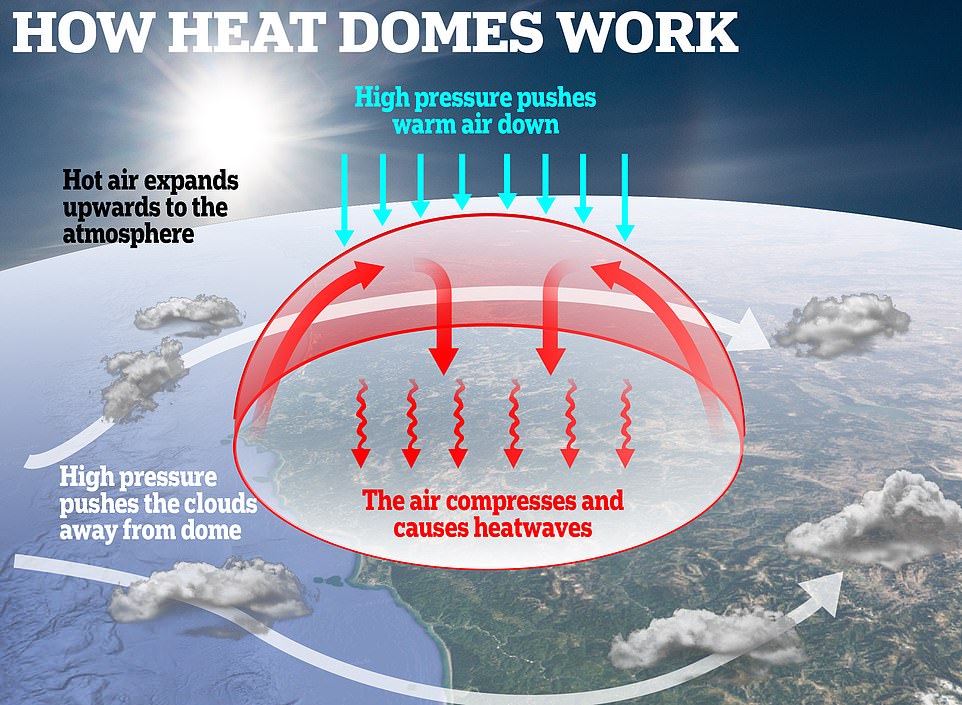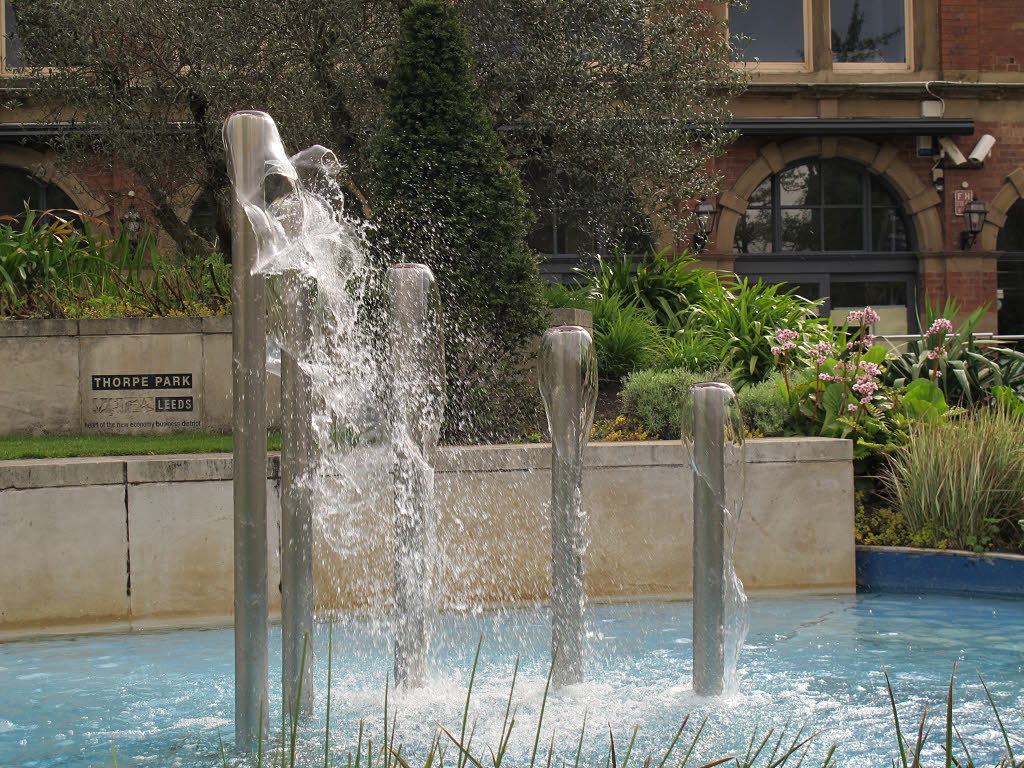My news feed has been filled in recent weeks with many stories about the unusual heat that has affected many parts of North America, Europe, and the Atlantic Ocean. High temperature records are being broken at an amazing rate, and while we don’t expect every day or season to break a new heat record, the trend towards warmer global temperatures overall from greenhouse warming makes periods of extreme heat more likely.
Today I want to talk about the term “heat dome” and explain what they are, how they affect gardeners (and other humans) as well as the plants in our gardens and agricultural fields. We had a great introduction to the physiological impacts of heat a few weeks ago in Jim Downer’s post “I’m hot! So are my plants!” on how high temperatures affect plant growth and respiration. If you have not already done so please read that for more details about heat’s impacts on garden plants.

What is a “heat dome?”
A “heat dome” is an expansive stationary area of high pressure that is associated with unusually hot temperatures. While slow-moving high-pressure areas are often seen in summer months, the size and unmoving nature of a heat dome coupled with the extremely high temperatures in the area beneath them make “heat domes” especially dangerous for humans and animals. They can also cause detrimental effects on many garden and agricultural plants because they are also associated with long dry spells along with high rates of evapotranspiration. The term “heat dome” is a phrase that has been popularized by the news media as a way to explain extreme heat events across large regions and is more jargon than a true scientific term, but it is certainly descriptive!

Any high-pressure center in the atmosphere is characterized by sinking air, light winds, and relatively cloud-free skies. The sinking air heats up as it compresses near the surface, and the rising temperatures are enhanced by the lack of clouds, which lead to more incoming sunlight and even warmer air in summer. Pavement also absorbs sunlight and radiates it out at night, leading to overnight low temperatures that can be in the 90s in extreme cases.
When the center of high pressure is locked in place over one area over a long time period, it tends to divert cooler, moister air away. That makes it appear as though there is a glass dome overlying the area blocking rain from falling. The hot and dry conditions tend to get worse quickly, leading to temperatures that in the worst cases can break records. This week many daily high temperature records were broken in the western United States as well as in parts of Europe. If the air is already warmer than average to begin with, that makes it even easier to reach record high temperatures. Often, a very wavy but stagnant pattern in the upper-level winds causes a series of heat domes to form across the globe, leading to heat waves at several locations at the same time.

What danger does a heat dome cause to gardeners?
Air in the center of the high pressure that makes up the heat dome tends to trap pollutants in a shallow layer near the surface of the earth. This can lead to episodes of smog and high surface ozone that can cause health effects on people, especially children and people with poor lung function. It can also trap smoke from wildfires, as I discussed last month. The trapped pollution makes it hard to breathe and can cause lung damage as well as leaf damage on plants. Temperatures that stay in the 80s or higher overnight do not allow human and animal bodies to cool down to their normal temperature, resulting in health issues that build up over several days as the heat wave continues. Phoenix has experienced every day this July with a maximum temperature of 110 F or higher, and has seen deaths due to heat increase, especially in homeless populations that have little access to cooling. Deaths from heat spells increase after several days of extreme temperatures when the body is not able to cool itself down and the heat causes physiological changes that can lead to severe impacts. While drinking a lot of water is important for hydration, it is not enough to fend off the impacts of the high temperatures. You must find a way to cool off or your health will suffer.
Humidity is also a factor in heat-related illnesses. Humans cool their bodies off by sweating. The moisture is evaporated from the skin, leading to an energy transfer that makes the skin cool off as the sweat is changed to water vapor. But if the humidity is too high, evaporation is so slow that it can not provided the needed cooling, and the body stays hot. That can eventually lead to death. In fact, it is not just humans and terrestrial animals to suffer. The water temperature near southern Florida this week was near 100 F, leading to predictions that the coral reefs in the ocean there would soon die because it is too hot for them to survive, much less thrive. This is also happening in other ocean locations around the world. Since coral reefs provide food and shelter for many marine species like fish, it is likely to cause dire consequences for the oceanic food chain, including those of us who eat shrimp, fish, and other seafood.

What do gardeners need to do when a heat dome is forecast?
When a heat wave or heat dome is predicted, gardeners and farmers should recognize that a protracted period of extremely hot, oppressive conditions is likely to occur. The first action they should take is to make sure they are protected from the effects of the heat. That means working outside early in the day when it is cooler, drinking plenty of water, wearing light-colored clothing to reflect sunlight, and taking plenty of breaks in the shade or air conditioning. They should take care of pets and livestock as well and consider keeping them inside or in shady places with plenty of water for drinking. They should monitor their plants carefully for signs of heat stress and water regularly to reduce the impacts of the hot, dry conditions. Trees should also be watered, especially if they are not well established or if the dry period is especially lengthy. If the humidity is high, watering incorrectly can increase the likelihood of fungal diseases, so read Linda Chalker-Scott’s article Water: Garden Friend….and Foe? – Water, Relative Humidity, and Plant Diseases – The Garden Professors™ to learn the best ways to water your plants and preserve soil moisture. Saving Your Trees From Drought! – The Garden Professors™ also provides information about watering trees during dry periods.
Eventually, all heat domes and dry spells do pass, but it is always good after one is over to assess how your garden did and to plan ahead to protect soil moisture using some of the techniques mentioned in the links above.

Thanks for this explanation and related tips. However, it’s not just humans at risk (we only caused this). Here in NJ I’ve only seen one lone monarch so far. They usually start arriving with the July 4 celebration, but there’s been zero nibbling on the milkweed leaves this year. I wonder if many didn’t survive the Texas heat.
Thanks, that is an important point. It is not just humans and animals that suffer but entire ecosystems. I mentioned the Florida coral reefs but pollinators also respond to heat and drought, so they are definitely at risk too. Thanks for your observations about monarchs, I don’t usually see many here but am glad you are keeping track of them. I think the Texas heat may have been a factor, although there is also loss of habitat and other contributing factors.
Heat records are almost never broken here (Kansas) because they were all set in the 1930’s. Yesterday was 92ºF here, right near the average high. The record for August 5th here is 109ºF, set, of course, in 1934.
The Dust Bowl of the 1930’s was an extraordinary time period for the central US. July and August 1934 were the some of the hottest months on record for Kansas so it would be hard to break those records. Most other states in the United States do not have a similar pattern (you can check at https://www.ncei.noaa.gov/access/monitoring/climate-at-a-glance/statewide/time-series/). No wonder that so many people had to leave the Plains due to the heat and drought!